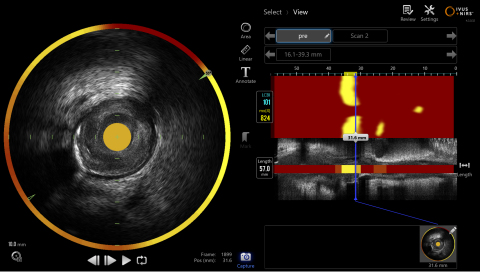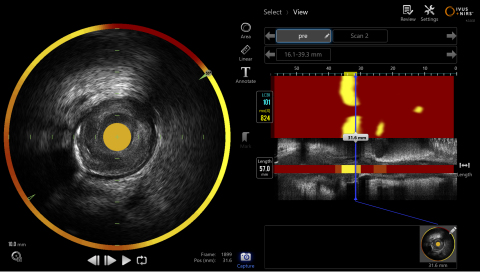BURLINGTON, Mass.--(BUSINESS WIRE)--Infraredx, Inc., a pioneer in intravascular imaging for mapping coronary artery disease, presented late-breaking clinical trial results for its landmark Lipid-Rich Plaque (LRP) Study today at the 30th Transcatheter Cardiovascular Therapeutics (TCT), the annual scientific symposium of the Cardiovascular Research Foundation. Cardiovascular disease remains the number one cause of death globally, accounting for 31 percent of deaths,1 and despite optimal medical therapy and risk modification strategies, coronary events continue to occur. The LRP Study demonstrated the ability of intravascular ultrasound (IVUS) and near-infrared spectroscopy (NIRS) technology to identify patients and coronary plaques as vulnerable to future major adverse cardiovascular events (MACE), such as heart attacks.
Numerous autopsy studies have found that lipid core plaque (LCP) is the underlying cause of most coronary deaths, and ruptured lipid cores are thought to cause most MACE events in vivo. Intravascular NIRS was developed, validated, and labeled for the detection of LCP, and preliminary small-scale clinical trials have demonstrated the clinical feasibility of NIRS detection of patients at elevated risk of future MACE. The LRP Study validates and expands upon these earlier studies through its larger size, rigorously pre-specified methods, and true focal vulnerable plaque based co-primary endpoints.
Infraredx’s Makoto™ Intravascular Imaging System, with accompanying Dualpro™ IVUS+NIRS catheter, is the only technology on the market FDA-cleared for the detection of LCP. The system utilizes NIRS to detect LCP and automatically displays the results via a simple, color-coded map, called a chemogram. The chemogram allows for the straightforward display of the presence of LCP in yellow and absence in red. The ability to detect LCP in order to stratify at-risk patients will enable cardiologists to make more personalized clinical decisions for their patients.
The prospective, multicenter LRP Study enrolled 1,563 patients from 44 sites across the U.S. and Europe. Stable and unstable patients requiring an angiogram procedure for new or ongoing cardiac symptoms were included in the study after their initial treatment was completed. IVUS+NIRS technology was then utilized to assess patient and plaque lipid core burden index (LCBI), a quantitative summary metric of LCP in the chemogram. In order to have a single numerical diagnostic value to compare to incidence of future MACE, a metric was derived from the chemogram as the maximum lipid burden in any 4mm segment (maxLCBI4mm). The maxLCBI4mm metric was computed on each patient and each coronary segment and the patients were followed for 24 months to observe incidence of MACE.
The study met its co-primary endpoints: the association of patient-level maxLCBI4mm with vulnerable patients, those who are likely to experience any non-culprit MACE, and the association of plaque-level maxLCBI4mm with vulnerable plaques, lesions within a pre-imaged segment likely to cause a future MACE in that specific segment. In evaluating vulnerable patients, the study found the occurrence of a non-culprit, or unstented, MACE event within 24 months is 18 percent higher with each 100 unit increase in maxLCBI4mm. Specifically, a patient with a maxLCBI4mm greater than 400 is at 87 percent higher risk than a patient with a lesser maxLCBI4mm. In plaque-level analyses, risk of experiencing an event within a vulnerable coronary segment within 24 months is 45 percent higher with each 100 unit increase in maxLCBI4mm; and, the likelihood of an event in a coronary segment with a maxLCBI4mm greater than 400 is 411 percent higher than a segment with a lesser maxLCBI4mm.
“These results have the potential to transform not only the field of intravascular imaging, but how we practice interventional cardiology,” said LRP Study principal investigator Ron Waksman, M.D., FACC of the MedStar Heart and Vascular Institute in Washington, D.C. “The ability to identify lipid core plaque and risk stratify patients by the probability of MACE could open up new and transformational opportunities for cardiovascular research and treatment strategies.”
“The role lipid rich plaques play in cardiovascular-related deaths has been studied for decades. Today’s findings validate that NIRS use in vivo can identify both vulnerable patients and vulnerable coronary plaque. We are grateful to the physicians, patients and employees who have helped to achieve this transformational milestone,” said Jason Bottiglieri, President and CEO of Infraredx. “We are proud our technology has contributed to these important findings, and we will continue our fight against cardiovascular disease, working to empower physicians to discover new treatments and preventive medicines.”
The company recently launched the Makoto™ Intravascular Imaging System, and accompanying Dualpro™ IVUS+NIRS catheter, in Japan, the world’s largest imaging market. The launch followed a successful Spring 2018 limited market release, which included more than 10 hospitals in Japan. Infraredx plans for to launch the product in the U.S. in early 2019.
About Infraredx, Inc.
Infraredx, Inc., a Nipro company, is advancing the diagnosis and management of coronary artery disease by providing cardiologists with the most precise imaging tools required to predict and ultimately prevent heart attacks. Its Makoto™ Intravascular Imaging System, with accompanying Dualpro™ IVUS+NIRS catheter, is the only technology on the market that is FDA-cleared for the detection of lipid core plaque (LCP). LCP, suspected to be vulnerable plaque, is well-documented in studies as the cause of most serious heart attacks. Infraredx is dedicated to advancing this important field of research and conducting landmark clinical trials to transform how we view and treat heart disease. For more information, please visit www.infraredx.com and connect with Infraredx on Twitter and LinkedIn.
1 Cardiovascular diseases (CVDs). (2017, May 17). Retrieved from http://www.who.int/en/news-room/fact-sheets/detail/cardiovascular-diseases-(cvds).




